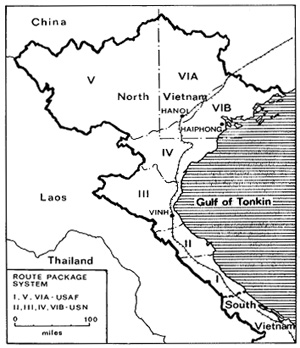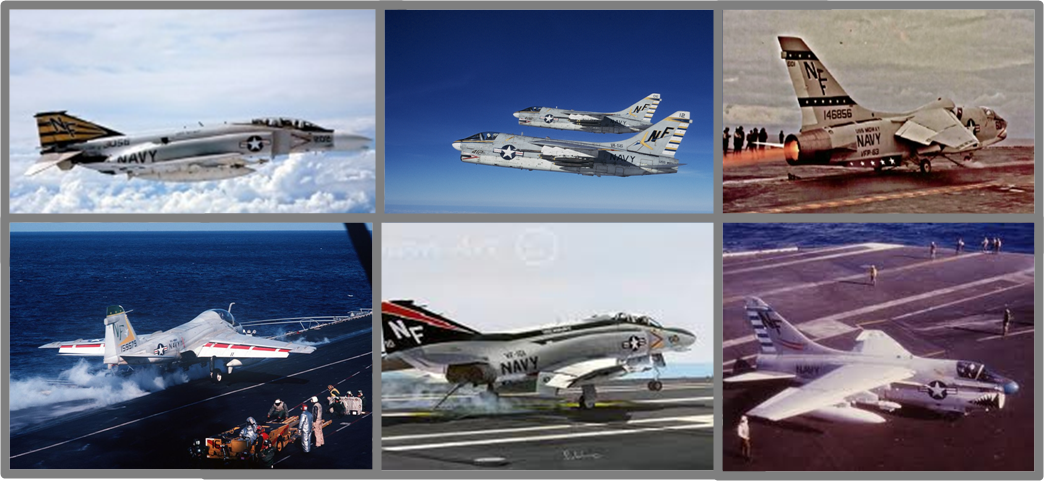On May 10th, three and a half years after Lyndon Johnson called a halt to the Rolling Thunder campaign, Richard Nixon authorized the full-scale resumption of bombing operations against North Vietnam. the new operation was called Linebacker and the rules of engagement were different. 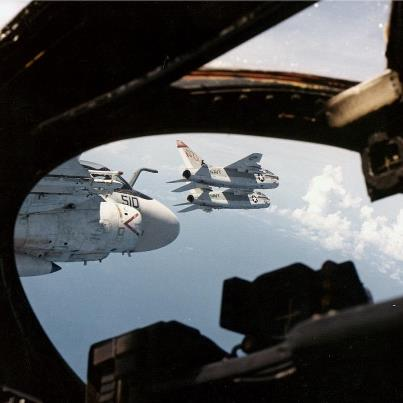
Excerpts from Chapters 30-33
Not on My Watch, by Dave ‘Snako’ Kelly
The U.S. had halted bombing of the North Vietnam in 1968. In early 1972, when the decision had been made that we wanted to end the damn war, air power was selected as the weapon of choice. (RS note: As discussed in a previous post, USS Midway and Carrier AirWing Five left Alameda California on 10 April 1072 and commenced combat operations on the 29th On 10 May, Midway proceeded to Yankee station and began operations against North Vietnam.)
Once MIDWAY moved to North Yankee Station in the middle of the first line period flight ops remained in North Vietnam until the war ended in the North. It wasn’t until our last line period in 1973 that we returned to the low-threat environment south of the DMZ.
The U.S. was capable of putting thousands of pounds of bombs on any part of Vietnam at any time during the war. Hence, at any time during the conflict I believe the war could have been ended in a matter of months. This is exactly what was done in December of 1972 during several weeks of bombing which targeted parts of North Vietnam’s key infrastructure and its leaders.) MIDWAY/CAG5’s operations consisted of three types of strike missions. During daylight 2 to 4-plane strikes were flown by F-4s, A-7s, and A-6s in RPs I to IV. At night A-7s frequented these same regions and also occasionally prosecuted targets along the coast in VIA. These ops were either against specific targets, or they were recce missions looking for movers (trucks and trains) transporting goods south The A-6s ran these same types of missions in these regions, but we were also task with targets deep in VIA & The most effective raids into the heartland of the north in 1972 were large multi-plane missions launched by both the Air Force and the Navy. And since these missions had many aircraft flying in a formation, they were all daylight missions. These missions were the Alpha Strikes we had practiced at NAAS Fallon prior to both cruises.
———————————————————————————————————-
For military planning and coordination the entire country had been divided into six Route Packages. The area of the country north of the Demilitarized Zone (DMZ) at the border of North and South Vietnam was designated Route Package I. Route Packages II, III, and IV were stacked above this area and covering the narrow southern portion of the country along the coast.
Route Package VI was the heartland of North Vietnam which included all the manufacturing areas, the large port city of Haiphong, and the inland capital of Hanoi. Route Package VI was further divided in two sub regions, 6A and 6B, with Hanoi on the border between the two operating zones. Route Package V was west of RP VIA.
As part of this stepped-up activity Air Force units primarily based in Thailand started flying missions in RP I through IV in the southern part of the country. Additionally the USAF covered RP V in the western mountains. The Navy flying from carriers in the Tonkin Gulf conducted missions in RP I to IV and in VIB in the south and eastern areas of the country. Both services conducted strikes in RP VIA and around the capital city of Hanoi.
———————————————————————————————————-
A-7s, F-4s, and A-6s all participated in the multi-plane Alpha Strikes conducted during the day. These missions were designed to put as much ordnance as possible on a high-valued target in the shortest possible time and with the least amount of risk. Alpha Strike targets included airfields, power plants, factory complexes, POL, air defense staging areas, and other parts of the enemy’s war-fighting infrastructure. Initially these strikes were in RPs I to IV and VIA. By the 3rd or 4th line period, Navy Alphas were also being conducted in and around Hanoi. With typically three or four daylight launches, the ship could only handle two or three Alpha Strikes per day. These missions were quite demanding on the aircrews and the maintenance personnel. The ship’s supply system was also pressed to keep replenishing the tons and tons of ordnance that the Alpha Strikes consumes.
The A-6 could carry more ordnance than any other carrier based aircraft. (And this is still true to this day!) The so-called medium attack bomber was hence called upon to support both of these missions, as well as its bread and butter, the low-level, single-plane night strikes into RP VIA & B, the heart of North Vietnam.
As a single plane mission, these night strikes were nowhere near as effective as the Alphas. I think they did, however, play an important role in the 24-hour harassment strategy. Having jets flying over and bombs going off both day and night sent a message to the intransient politicians in the North that we were back this time, and we meant business. These round-the-clock operations began in April of 1972 and didn’t end until January of 1973. VA-115 participated in this effort from May to January chalking-up 9 months of intense flight operations in this hostile environment. Of my approximate 200 combat missions about 70% were conducted during the 2nd cruise, and all but a handful of these were operations in the North.
Trying to put a lot of strike and support aircraft in the air using the two cats (The more modern carriers in the fleet had four catapults, two on the bow and two waist cats on the angle deck. MIDWAY was only equipped with bow cats) on the MIDWAY’s bow, joining them up, tanking, and getting them to the beach, and then finally getting them in and off target in a high-threat area, took an incredible amount of aerial choreography. The plan for the Alpha needed to do all those things, as well as, limiting unnecessary exposure to AAA & SAMs, protect the strike aircraft from MIGs, assure the most effective use of ECM/jamming, avoid midair collisions, and assure the success of the mission, i.e., bombs on target.
While the plan was developed by the Strike Leader, usually a very senior officer in one of the fighter or attack squadrons, the smart leaders also solicited inputs from the experienced attack pilots. And since the A-6s had spent more time in this part in the heartland of the country than anyone else on the ship, VA-115 was a good source of information.
About two hours before the launch, the crews for the Alpha Strike would gather in the Air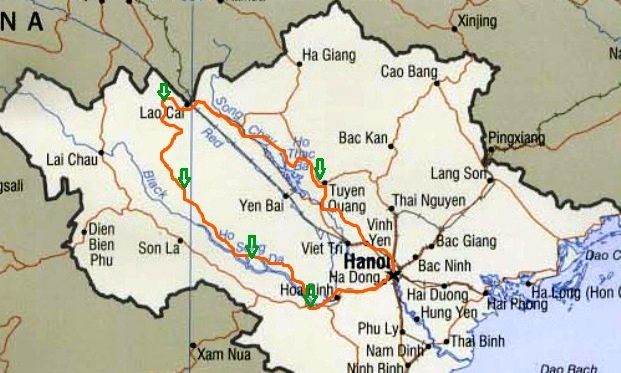 Intelligence (AI) spaces for the Pre-flight Briefing. The Alpha Flight Leader would have pre-planned the entire mission. First the AIs would go over theater-wide issues and any updates to the Air Order of Battle (AOB) (description of the threats and any changes to the enemy’s air defenses) with respect to the ingress or egress routes and the target area.
Intelligence (AI) spaces for the Pre-flight Briefing. The Alpha Flight Leader would have pre-planned the entire mission. First the AIs would go over theater-wide issues and any updates to the Air Order of Battle (AOB) (description of the threats and any changes to the enemy’s air defenses) with respect to the ingress or egress routes and the target area.
The Flight Leader would then provide a detailed briefing on all aspects of the mission: the rendezvous over the ship, tanking the strike and support aircraft, the route of flight to the beach, going ‘feet dry’, threat considerations and pre-emptive measures for both the MIGCAP (MIG Combat Air Patrol) and the Iron Hand, any sort of dog-leg maneuvers during the ingress phase (a change in heading to confuse the enemy), a description of the target, ordnance, and the fusing of the bombs, the roll-in sequence for each element of the strike, the aim point assignments for each element, and the plan for egress to ‘feet wet’.
If there were any go/no-go decisions or potential changes of the plan that needed to be made during the ingress or egress for things like weather, the point at which these decisions would be made, the expected radio transmissions to be made, and by whom they would be made, were also covered during the briefing.
Following the strike briefing detailed coordination between the support aircraft for the strike was addressed by the various players:
- The MIGCAP determined their tanking plan and their positioning to protect the strike aircraft from the MIG threat for both the ingress and egress routes. This typically involved stationing them over an enemy airfield or between the strike group and an airfield.
- Every F-4 in the launch went off the deck in afterburner, and needed to be topped-off prior to embarking on the mission. In addition the strike aircraft and MIGCAP, the Photo Recce escort and the BARCAP all needed to get ‘drinks’.
- The tankers met to discuss their strategy for refueling the strike and support aircraft, and their plan to keep as much fuel airborne as possible in the air. A “Yo-Yo” tanker would launch with the strike aircraft give as much fuel as possible to the strike aircraft, consolidate any remaining fuel into another tanker, and land with the recovery from an earlier flight
- The A-3 jammer needed to set up its position for the most effective ECM operation during both the ingress and the egress.
- The Iron Hand birds needed to determine their positioning and their timing for any pre-emptive launches of Shrike, anti-radiation missiles.
- The Photo Recce bird and his escort needed to set up their high speed dash over the target area to capture the BDA from the mission and avoiding the slow-moving (600 knot) attack aircraft.
For an Alpha Strike all the aircraft involved with the mission were launched as quickly as possible and climbed to the rendezvous altitude directly over the ship. Each strike element took off as closely as possible together, and then conducted a running rendezvous while spiraling up to the Alpha formation. If this all worked properly, the lead element would be in position and stabilized in a rendezvous turn circling the ship at a level altitude as each of the other 3 or 4 plane elements joined and slid into its respective position in the formation.
The result was a very crowed sky with up to 40 aircraft jockeying to get into their respective positions. It wasn’t, however, chaotic. Since the planes had been launched in sequence, all that was required was for each element to join expeditiously, and then proceed to the rendezvous circle and get into position.
F-4 elements typically needed to refuel after taking off and climbing all the way to altitude, so they rendezvoused with the tanker and began getting topped off. Depending on the timing for the strike, the Flight Leader might call for the Alpha to head-out prior to the F-4s getting into position. If that was the case then the tankers would shadow the strike as the F-4 elements filled their tanks and then proceeded to their designated positions in the formation. The MIGCAP and Photo Escort birds would also get topped-off as the strike proceeded to the target area and would bang-off on their respective missions.
The in-route portion of the flight for the strike group was normally conducted at 20,000 feet and around 475 knots. This was in deference to the A-6s who were carrying almost the same load as three of the other planes.
As the strike formation approached ‘feet dry’, the leader would push the throttles up and descend to the roll-in altitude typically around 15,000 feet.
The MIGCAP went ‘feet wet’ 10 – 20 miles ahead of the strike group and set-up orbiting positions to place themselves between likely threat airfields and the Alpha formation. These guys were ‘itching’ for a fight. They would typically hang out around 15,000 feet and keep their airspeed in the 600+ knots region. This was the heart of the F-4’s engagement envelop
Iron Hand Mission: Protection for the Alpha could also included an Iron Hand element. In CAG5 that was typically a pair of A-7 aircraft configured with anti-radiation (Shrike) missiles to counter the SAM threat. These guys were strategically position prior to the main body of the Alpha entering the SAM threat area. With only Shrikes on board the A-7s were light-loaded and fairly nimble. This gave them some advantage over the SAMs.  The Iron Hand typically set up a racetrack pattern with one aircraft always pointed at or near the anticipated SAM site. With this orientation, if or when a site went active, they could easily get a weapon in the air.
The Iron Hand typically set up a racetrack pattern with one aircraft always pointed at or near the anticipated SAM site. With this orientation, if or when a site went active, they could easily get a weapon in the air.
The Iron Hand birds would monitor their ECM gear looking for signs of Fansong Radar activity (SAM acquisition and guidance radar). If a site launched a missile or acted like it was preparing to launch a missile, the Iron Hand would respond by launching a faster anti-radiation seeking missile. The idea of this was to destroy the Fansong radar associated with the SAM site or forcing the site to stop transmitting guidance commands to the airborne SAM. Without the guidance commands, the SAM turned into a mach 1.5 rocket instead of a radar-guided weapon.
Alpha goes ‘feet dry’: Depending on the coast-in point, our ECM equipment would start to light-up shortly after ‘feet dry. The audio cacophony would continue and increase as we flew the last 10 or 40 miles to the roll-in point for the attack. At the Strike Leader’s command, the individual elements of the strike would initiate a formation roll-in following the prescribed choreography presented at the Pre-flight Briefing. Each element would leave the formation, as the strike group wheeled around the target.
The elements attacked their designated aimpoint in the target area, dropped their bombs, and then leveled-off at about 3500 feet above the ground. For the egress it was full throttle for the A-6s giving us something on the order of 550 knots during the low altitude dash to ‘feet wet’.
The SAM threat was greatest during the ingress, AAA could get you in the target area, and enemy fighters and random AAA were the menaces during egress. Marauding MIGs flying low to avoid the MIGCAP, would try to pick-off the strike aircraft as they dashed to the water.
During the egress the elements would generally operate as two 2-plane sections staying somewhat together during the 3-4G jinking maneuvers. This tactic minimized the risk of being hit by ground fire, and it allowed each aircraft to clear his wingie’s 6 o’clock. Once the bombers had cleared the target area, and we were on our way to ‘feet wet’, the MIGCAP would follow us out. Their mission was now to look for MIGs that might try to pick-off stragglers.
The F-8’s mission was to collect photographic evidence of the success of the strike, i.e., Bomb Damage Assessment (BDA). He had an F-4 escort because they never wanted a single plane in combat by itself. (Unless of course it was an A-6, and you were flying at night!) While the strike aircraft were streaking to the coast, the F-8 and his chase set up for their high speed run. They typically made the run from a different direction than the strike, and they made the run at greater than Mach 1.
Note: I overheard the photo pilot and the escort briefing before one of the strikes. The F-8 driver was cautioning the escort about A-7s and A-6s ‘hovering’ near the coast-out point. I told him that we would be doing 500-600 knots. He just smiled and said, “At Mach 1.4 you guys look like your just hovering.”
Alpha to Bia Thong: I participated in about 40 Alpha Strikes. When you get this many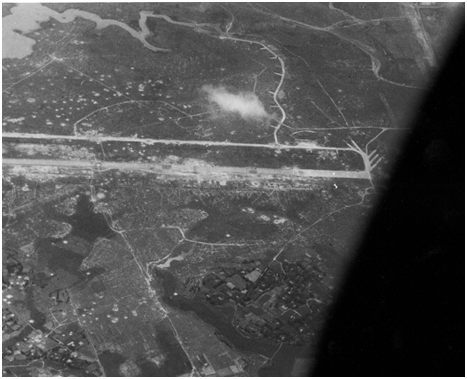 planes in the air and try to get them in and off target safely in a high threat area like the Red River Valley, there were always some harrowing experiences. On an Alpha to the Bia Thong Airfield near the heavily defended city of Thanh Hoa at the top of RP IV, Shylock (Dave’s BN) had a handheld camera and managed to snap a few pictures.
planes in the air and try to get them in and off target safely in a high threat area like the Red River Valley, there were always some harrowing experiences. On an Alpha to the Bia Thong Airfield near the heavily defended city of Thanh Hoa at the top of RP IV, Shylock (Dave’s BN) had a handheld camera and managed to snap a few pictures.
As the Alpha crossed the beach, it looked like we would have to abort the mission due to a near solid 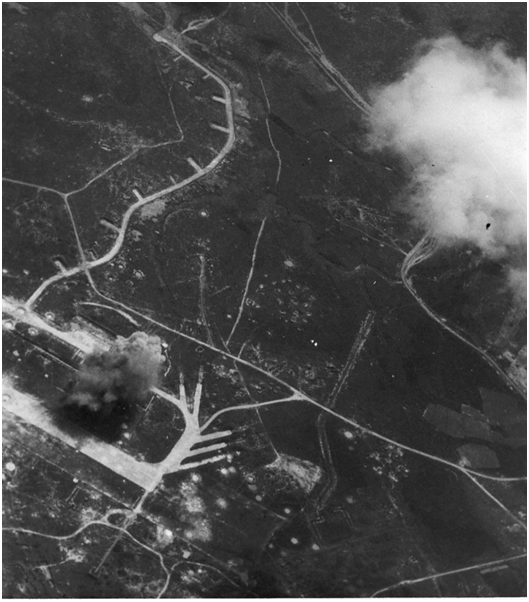 overcast condition. The MIGCAP, however, had reported that the target area was partially clear. With that assurance the strike leader continued the attack. And when we got to the target area we found scattered clouds in the target area.
overcast condition. The MIGCAP, however, had reported that the target area was partially clear. With that assurance the strike leader continued the attack. And when we got to the target area we found scattered clouds in the target area.
The target was completely visible through breaks in the clouds, so the leader called the roll-in. Most of the planes released their weapons high to avoid going into the clouds. For some reason Shylock and I pressed the attack. When we leveled-off, we were below the clouds. For the enemy defenses, bombs had just fallen on their runway, and our aircraft became the focal point for their air defenses. Fortunately they didn’t get any lucky shots.
NEXT: Specific Alpha Strike and night mission stories from Not On My Watch

